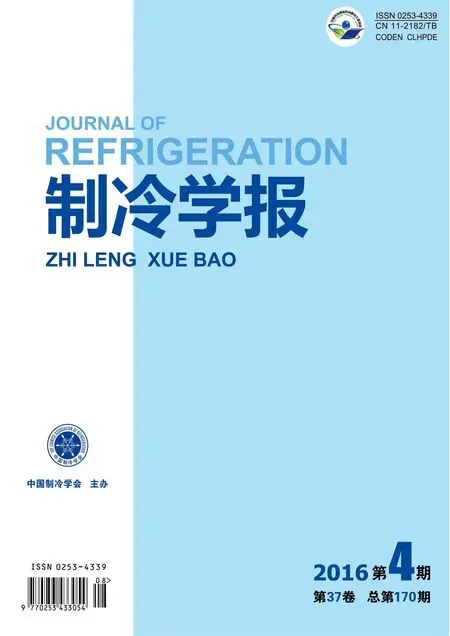能源总线系统多热源混水和热回收过程变分析
王培培 龙惟定
(1同济大学 机械与能源工程学院 上海 200092; 2 同济大学 中德工程学院 上海 200092)
王培培1龙惟定2
(1同济大学 机械与能源工程学院上海200092; 2 同济大学 中德工程学院上海200092)
在能源互联网时代,区域供冷供热系统将由原本单一形式的热源向多种形式热源并存转变,尤其是可再生能源和未利用能源。不同形式不同品位的热源集成必将引起系统能量变化。能源总线系统是集成化规模化应用区域内可再生能源及未利用能源的多源多用户能源系统。本文针对能源总线系统相对常规分散系统而言特有的多源多用户特征进行系统混水和热回收过程的变分析,将能源总线系统抽象为一系列工作在高温热源和低温热源之间的劳伦兹循环的集成,通过建立能源总线系统与常规分散系统的理想热力学模型,找到能源总线系统混水和热回收过程变的规律及影响因素。结果表明:系统的变化与各子系统低温热源进出口温度、高温热源进口温度以及高低温热源质量流量比相关,不同的设计参数会导致混水过程能量发生增加或者减小,亦或不变。通过分析得到热回收过程影响源侧总线热量变化的相关参数并找到热量变化规律,并得到最佳总线供水温度TEBS1的确定方法。
能源总线系统;能源规划;劳伦兹模型;热回收;

1 能源总线系统理想热力学模型
能源总线系统实质是由一系列制冷制热循环系统集合而成的冷热量交换系统。将实际制冷制热循环系统抽象为工作于一定高温热源和低温热源之间的逆卡诺循环。考虑热源流体与冷源流体进出口温度会随着吸热放热过程而改变,理想循环的热源都具有一定的比热容(也不是无限大),因此,将能源总线系统视为工作在一系列变温热源组成的理想循环(即劳伦兹循环)中的冷热量交换系统。
对夏季制冷工况进行理论分析。理想能源总线系统夏季循环可视为工作在总线的高温热源TEBSm和不同低温热源Tlmi之间的一系列劳伦兹循环。能源总线系统与常规分散能源系统的理想热力学模型的对比,见图1、图2。其中,总线中水的高温热源TEBSm为多源混合热源,即由不同高温热源Thmi组合而成。多源混合过程存在流体掺混,流体掺混过程带来的能量变化直接影响能源总线系统运行和设计,下面对热源混合过程中能量在数量与质量上的变化进行分析。

图1 能源总线系统制冷工况理想热力学模型Fig.1 Ideal thermodynamic model of the energy bus system in cooling mode

图2 常规系统制冷工况理想热力学模型(基准模型)Fig.2 Ideal thermodynamic model of the conventional system in cooling mode
2 能源总线系统多源混水过程变计算

2.1 EBS制冷循环能量平衡计算模型
夏季制冷循环的能量平衡计算模型见图3。设定:区域i夏季制冷循环过程低温热源温度由Tli1变化到 Tli2,常规系统区域i的高温热源温度由Thi1变化到Thi2,能源总线系统热源温度由TEBS1变化到TEBS2。系统运行环境温度T0。则有:

图3 制冷循环能量平衡模型Fig.3 Refrigeration cycle energy balance model
QNi+Wi=QKi
(1)
(2)
(3)
(4)
劳伦兹循环温度之间的关系为[17]:
(5)
(6)
(7)
式中:C1、C2分别为两个热源流体的比热容;Tlm、Thm、TEBSm分别为低温热源、高温热源以及总线热源的热力学平均温度。
根据高温热源与低温热源温度计算常规系统与能源总线系统劳伦兹循环制冷系数ε1:
(8)
(9)


图4 制冷循环平衡模型Fig.4 Exergy balance model of refrigeration cycle

ExQNi+∑Li=Wi+ExQKi
(10)
(11)
(12)
(13)


(14)

(15)
3 EBS制冷工况多源混水过程影响变主要影响因素分析



已知 Th21≠Th11,当Th21=Th11时,源侧温度相同,不存在混合变化,即ΔW1=0 。令Th21>Th11,即(Th21-Th11)>0,则有:


根据公式(15)分析能量相对变化ΔW1%的正负与大小,令n=2。
ΔW1%=
(16)
选定变量为τ1、τ2、φ1,分析公式(16),设定Tl11=Tl21=273+12=285K,Tl12=Tl22=273+7=280K,Th11=293K,Th21=305K,即两个系统制冷循环低温热源进出口温度Tl1、Tl2相同时,分析不同φ1,τ1,φ2,τ2条件下,源侧进水温度293 K和305 K混合后系统循环相对功耗变化量,此时的ΔW1%是φ1,τ1,τ2的函数(φ2=1-φ1),即ΔW1%=f(φ1,τ1,τ2)。
设定τ1、τ2的变化范围为[0.8,1.0],φ1的变化范围为[0.1,0.9]。
计算结果见图5。图中可以看出,ΔW1%max=3.71%,ΔW1%min=-3.63%。功率变化趋势证明前面对于能量损失定性分析的正确。

图5 制冷工况高温热源侧混水过程能量相对变化(切片φ1)Fig.5 Relative energy change in water mixing of high temperature heat source side in cooling mode (Cut φ1)



表1 制冷工况混水能量相对变化极值函数拟合结果
(17)
4 EBS热回收过程功率变化及最佳供水温度分析
设定能源总线系统总线热源温度由TEBS1变化到TEBS2i或TEBS2j;有n1个区域进行制冷循环,低温热源温度分别由Tli1变化到 Tli2,常规系统区域i的高温热源温度由Thi1变化到Thi2;有n2个区域进行制热循环,高温热源温度分别由Thj1变化到Thj2,常规系统区域j的低温热源温度由Tlj1变化到 Tlj2;系统运行环境温度T0;设定高低温热源流体比热C相等。设定外界温度T0,此时采用常规热泵系统的i区域中,Thi1=T0;采用常规热泵系统的j区域中,Tlj1=T0。QNi、QKj为各区域冷热负荷,设定δ为全部区域总冷、热负荷之比。

同样设定全部i区域 Tli1=285 K,Tli2=280 K,τi=1,全部j区域Thj2=318K,Thj1=313K,τj=1。可以得到:
能源总线系统能耗WEBS与总线供水温度TEBS1、区域冷、热负荷比例δ相关联,见图6。当确定了区域的总冷、热负荷比例δ之后,对应室外温度T0,可以从图中确定更节约输入功率的总线水温度TEBS1。
δ>0.88时,总线放热量大于吸热量,WEBS随着TEBS1升高而增加;δ=0.88时,总线内冷热平衡,WEBS与TEBS1大小不相关;δ<0.88时,总线吸热量大于放热量,WEBS随着TEBS1升高而减少。

图6 供水温度和区域冷、热负荷比例对EBS能耗的影响Fig.6 Influence of supply water temperature and ratio of regional cold load and heat load on EBS energy consumption
5 结论

[1]王培培,龙惟定. 小型能源总线系统全年动态热力性能仿真分析[J].制冷学报,2015,36(2): 59-64. (WANG Peipei, LONG Weiding. Numerical analyses on dynamic thermal performance of small energy bus system[J]. Journal of Refrigeration,2015, 36(2):59-64.)
[2]王培培,龙惟定,白玮.能源总线系统研究—半集中式区域供冷供热系统[J].湖南大学学报(自然科学版),2009, 36(12):137-141. (WANG Peipei, LONG Weiding. Study on energy bus system-semi-central DHC [J]. Journal of Hunan University (Natural Sciences),2009,36 (12):137-141.)
[3]Wang P P, Long W D. Research on energy consumotion of regional distributed heat pump energy bus system [J]. Advanced Materials Research, 2012, 374-377: 425-429.
[4]Phetteplace G, Sullivan W. Performance of a hybrid GCHP system[J]. ASHRAE transactions, 1998, 104(1): 763-770.
[5]Chiasson A D, Spitler J D, Rees S J, et al. A model for simulating the performance of a Pavement Heating System as a Supplemental heat rejecter with closed loop ground source heat pump systems[J]. ASME Journal of Solar Energy Engineering, 2000, 122:183-191.
[6]Chiasson A D, Spitler J D, Rees S J, et al. A model for simulating the performance of a shallow pond as a supplemental heat rejecter with closed loop ground source heat pump systems[J]. ASHRAE Transactions, 2000, 106(2): 107-121.
[7]Shawn Alex Hern. Design of an experimental facility for hybrid ground source heat pump systems[D].Oklahoma: Oklahoma State University, 2004.
[8]林俊,胡映宁,李助军. 混和型地源热泵系统运行特性试验研究[J].太阳能学报, 2007, 28(11):1206-1212. (LIN Jun, HU Yingning, LI Zhujun. Study on compound ground source heat pump system[J]. Acta Energlae Solaris Sinica, 2007, 28(11):1206-1212.)
[9]Hackela S, Pertzbornb A. Effective design and operation of hybrid ground-source heat pumps: Three case studies[J]. Energy and Buildings, 2011, 43(12): 3497-3504.
[10] 龙激波,裴清清. 水环热泵空调系统在夏热冬暖地区应用经济分析[J].建筑热能通风空调,2004,.23(6):45-48. (LONG Jibo, PEI Qingqing. The economy analysis of WLHP air-conditioning system in hot summer and warm winter zone[J]. Building Energy & Environment, 2004,23 (6):45-48.)
[11] 张志强,姜益强,姚杨,等. 水环VRF空调系统及其工程应用[J]. 制冷空调与电力机械, 2006, 27(4):59-61. (ZHANG Zhiqiang, JIANG Yiqiang, YAO Yang, et al. Water loop VRV air conditioning system and its engineering applications[J]. Refrigeration Air Conditioning & Electric Power Machinery, 2006, 27(4): 59-61.)
[12] 黄倩,章学来,梁峻. 水环热泵—空气源热泵—热泵型热水机组复合空调系统的工程应用实例分析[J].制冷空调与电力机械, 2008, 29(3): 42-45.(HUANG Qian,ZHANG Xuelai, LIANG Jun. Application analysis of the air conditioning systems composed water-loop heat pump, air source heat pump and water-water heat pump [J]. Refrigeration Air Conditioning & Electric Power Machinery, 2008, 29(3): 42-45.)
[13] 刘天伟,杜垲.水环热泵空调系统应用于综合办公建筑的节能性研究[J].暖通空调, 2010, 40(3): 63-67.(LIU Tianwei, DU Kai. Research on the energy saving of water loop heat pump system applied to office buildings[J]. Heating Ventilating & Air Conditioning, 2010, 40(3): 63-67.)
[14] 孙婷婷. 水环多联式热泵空调系统运行特性研究[D]. 哈尔滨: 哈尔滨工业大学, 2012.
[15] 许霞. 地埋管地源水环热泵空调系统工程设计[J].暖通空调, 2013, 43(1):46-50. (XU Xia. Analysis and engineering application of water-loop heat pump air-conditioning system[J]. Heating Ventilating & Air Conditioning, 2013, 43(1):46-50.)
[16] 万鑫, 翁政军.水环热泵空调系统分析及应用[J]. 建筑技术, 2015, 46(10):898-900. (WAN Xin, WENG Zhengjun. Analysis and engineering application of water-loop heat pump air-conditioning system[J]. Architecture Technology, 2015, 46(10):898-900.)
[17] 马一太,田华,刘春涛,等.制冷与热泵产品的能效标准研究和循环热力学完善度的分析[M].北京:科学出版社,2012.
About the corresponding author
Wang Peipei, female, Ph. D., School of Mechanical Engineering, Tongji University, +86 13916459060, E-mail: wwwangwangaaa@163.com. Research fields: district energy planning, low carbon building and energy-saving building.
Analyses of Exergy Change in Multi Heat Source Water Mixing and Heat Recovery Process of Energy Bus System
Wang Peipei1Long Weiding2
(1. School of Mechanical Engineering, Tongji University, Shanghai, 200092, China; 2. College of Engineering in Germany, Tongji University, Shanghai, 200092, China)
In the internet era of energy, district heating and cooling system will change from a single form of energy to the various forms of energy, especially renewable energy and untapped energy. Integration of different grades of heat sources will cause system energy change. The energy bus system is a multi-source and multi-user thermal energy system that can make integration of renewable energy sources or untapped energy sources in large scale for district heating and cooling. This paper focus on analysis of exergy change in multi-source water mixing and heat recovering process of energy bus system comparing with the conventional system. The energy bus system can be modeled as integration of a series of Lorenz cycles. Through the theoretical analysis of the ideal thermodynamic model of energy bus systems and conventional distributed systems, exergy change law and its influencing factors in multi-source water mixing process and heat recovering process of energy bus system are analyzed. The results show that the inlet and outlet temperatures of each subsystem low temperature heat sources、inlet temperatures of high temperature heat sources、the mass flow ratio of low temperature heat sources to high temperature heat sources affect exergy change of multi-source system. Different design parameters can cause the energy to increase or decrease, or unchanged. In this paper, heat recovering process of energy bus system is also analyzed theoretically, and the related parameters which affect the heat change of the bus side are obtained and the heat variation law is found, also the way to get the optimum bus water temperatureTEBS1.
energy bus system; energy planning; Lorenz model; heat recovery; exergy
0253- 4339(2016) 04- 0106- 06
10.3969/j.issn.0253- 4339.2016.04.106
2016年3月16日
TU831
A
简介王培培,女,博士,同济大学机械与能源工程学院,13916459060,E-mail: wwwangwangaaa@163.com。研究方向:区域能源规划及低碳节能建筑。

